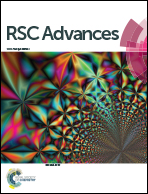The development of a light-up red-emitting fluorescent probe based on a G-quadruplex specific cyanine dye†
Abstract
A cyanine dye-dimethylindole red containing an extending polymethine chain, a sterically bulky dimethylindole heterocycle and an anionic propylsulfonate substituent on the quinoline ring was found to behave as a high specific light-up G-quadruplex probe in the red-emitting region above 650 nm, especially for parallel G-quadruplex c-myc. The 10 to 70-fold enhancement in the fluorescence quantum yield of dimethylindole red when incubating with G-quadruplexes may benefit more accurate definition of the distribution of G-quadruplexes across the genome.


 Please wait while we load your content...
Please wait while we load your content...